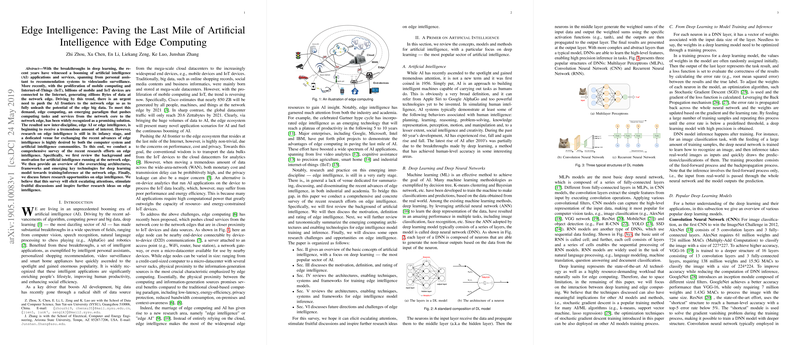This paper provides a comprehensive survey of recent research efforts on Edge Intelligence (EI), an emerging field that combines AI with Edge Computing. The authors argue that pushing AI to the network edge is crucial for fully unleashing the potential of edge big data, addressing limitations in performance, cost, and privacy associated with traditional cloud-based AI solutions.
Here's a breakdown of the paper's key components:
1. Introduction and Motivation:
- The paper begins by highlighting the advancements in AI, particularly deep learning, and its impact on various applications.
- It emphasizes the shift in data sources from cloud datacenters to edge devices (mobile and IoT), leading to an urgent need for edge-based AI.
- The authors discuss the challenges of cloud-based analytics (high cost, latency, privacy concerns) and on-device analytics (limited resources) and positions edge computing as a promising solution.
- The paper defines Edge Intelligence as the leveraging of edge resources to gain AI insights, and notes that it has started to gain a lot of traction from both academia and the industry.
- The paper addresses the gap regarding a dedicated venue for summarizing, discussing, and disseminating recent EI advances, which motivates the survey.
2. Background on AI:
- The paper provides a concise overview of AI concepts, focusing on deep learning, the most popular branch of AI.
- It covers key concepts like Machine Learning (ML), Artificial Neural Networks (ANN), and Deep Neural Networks (DNN).
- It describes different types of DNNs, including Multilayer Perceptrons (MLPs), Convolutional Neural Networks (CNNs), and Recurrent Neural Networks (RNNs), highlighting their architectures and applications.
- The paper also touches on Generative Adversarial Networks (GANs) and Deep Reinforcement Learning (DRL), providing an overview of their structures and use cases.
- It emphasizes the process of deep learning model training (feed-forward and backpropagation) and inference.
3. Edge Intelligence Definition and Scope:
- The paper discusses the motivation and benefits of edge intelligence, emphasizing the complementary nature of AI and edge computing.
- It highlights how AI can unlock the potential of edge data and how edge computing can enable richer AI applications and scenarios.
- The authors underscore the role of edge computing in AI democratization and the potential of AI applications in popularizing edge computing.
- Critically, the paper challenges the restrictive definition of EI as solely running AI algorithms locally on end devices.
- Instead, it proposes a broader definition where EI optimizes DNN model training and inference by leveraging data and resources across a hierarchy of devices, edges, and cloud datacenters.
- The paper introduces a 6-level rating system for EI, based on the amount and path length of data offloading: Cloud Intelligence, Cloud-Edge Co-Inference and Cloud Training, In-Edge Co-Inference and Cloud Training, On-Device Inference and Cloud Training, Cloud-Edge Co-Training & Inference, All In-Edge, All On-Device.
4. Edge Intelligence Model Training:
- The survey explores distributed DNN training at the edge.
- It classifies training architectures into Centralized, Decentralized, and Hybrid (Cloud-Edge-Device) modes.
- It identifies key performance indicators for distributed training: Training Loss, Convergence, Privacy, Communication Cost, Latency, and Energy Efficiency.
- The paper extensively reviews enabling technologies for improving these indicators: Federated Learning, Aggregation Frequency Control, Gradient Compression, DNN Splitting, Knowledge Transfer Learning, and Gossip Training.
- It provides a summary of existing systems and frameworks, showcasing their architectures, EI levels, objectives, employed technologies, and effectiveness.
5. Edge Intelligence Model Inference:
- The paper explores DNN model inference at the edge.
- It introduces four major edge-centric inference architectures: Edge-based, Device-based, Edge-Device, and Edge-Cloud.
- It defines key performance indicators for edge intelligence model inference: Latency, Accuracy, Energy, Privacy, Communication overhead, and Memory Footprint.
- The survey thoroughly reviews enabling technologies for improving these indicators: Model Compression, Model Partition, Model Early-Exit, Edge Caching, Input Filtering, Model Selection, Support for Multi-Tenancy, and Application-specific Optimization.
- It summarizes existing systems and frameworks, highlighting their target applications, architectures, EI levels, optimization objectives, adopted techniques, and effectiveness.
6. Future Research Directions:
- The paper identifies key open challenges and proposes future research directions:
- Programming and Software Platforms for heterogeneous EI environments.
- Resource-friendly Edge AI Model Design using AutoML and NAS techniques.
- Computation-aware Networking Techniques for efficient data sharing in distributed edge environments.
- Trade-off Design with Various DNN Performance Metrics, balancing accuracy, speed, and resource usage.
- Smart Service and Resource Management for efficient service discovery and task offloading.
- Security and Privacy Issues, including decentralized trust, privacy-preserving data training, and secure parameter sharing schemes.
- Incentive and Business Models for stimulating cooperation among EI ecosystem members, including the use of blockchain and smart contracts.
7. Concluding Remarks:
- The paper concludes by reiterating the importance of edge intelligence and its potential to revolutionize AI and IoT applications.
- It summarizes the key findings of the survey and highlights the open challenges and future research directions.
In summary, this paper offers a comprehensive and insightful survey of edge intelligence, covering its background, definition, key technologies, existing systems, and future research directions. It serves as a valuable resource for researchers and practitioners interested in this rapidly evolving field. The paper's breadth, depth, and forward-looking perspective make it a significant contribution to the understanding and advancement of edge intelligence.
